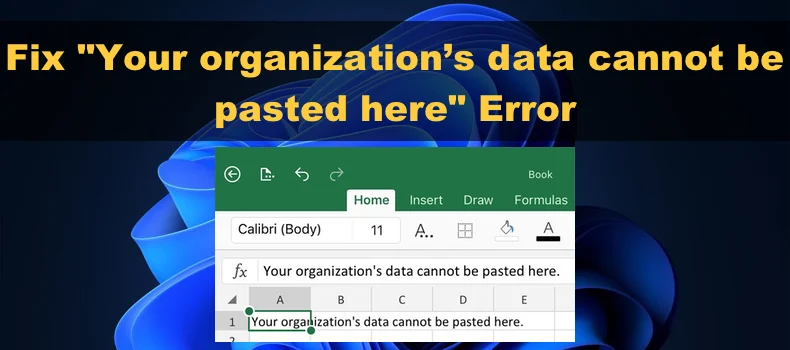The error message “Your organization’s data cannot be pasted here” typically appears when users try to copy and paste information between apps or documents that have specific restrictions or security policies in place. It’s often seen in corporate environments where sensitive or confidential data is being protected under strict data protection guidelines.
This error usually arises when an organization has applied data loss prevention (DLP) policies to prevent unauthorized sharing or mishandling of data. These policies are part of a security framework meant to ensure that employees cannot easily share sensitive information outside of authorized applications or platforms.
Why Does “Your Organization’s Data Cannot Be Pasted Here” Error Occur?
There are a few reasons why this error might appear:
- Data Loss Prevention (DLP) Policies: Many companies use DLP tools to safeguard sensitive information. These tools prevent users from copying and pasting data from one app or service to another if they detect that the data is confidential or regulated.
- App Restrictions: Certain applications, especially those used for managing corporate data, restrict the ability to copy or move information between apps to maintain data integrity and security.
- Cloud-based Services or Remote Work Environments: In a cloud-managed workspace or during remote work, organizations may have centralized data storage policies. If you’re working on a cloud app (like Microsoft 365 or Google Workspace), these tools might block actions like copy-pasting from one document or platform to another, ensuring no data is transferred inappropriately.
- Unauthorized File Types: Sometimes, copying and pasting might be restricted based on the type of file being transferred. For instance, if you’re attempting to paste sensitive files into an unapproved platform or app, security protocols will stop the action.
How to Fix “Your Organization’s Data Cannot Be Pasted Here” Error
If you encounter this error, there are a few solutions you can try:
- Check Organization Policies: If you’re in a corporate environment, it’s a good idea to check with your IT department or refer to the company’s data usage and security policies. They might have placed restrictions on certain apps or types of data for security reasons.
- Use Approved Applications: Ensure you are copying and pasting between apps that are approved by your organization. For example, some organizations may only permit copying data within secure, corporate-approved apps.
- Update Your Permissions: If the restriction is a result of permission settings, you may need to ask your organization’s IT team to adjust the settings on your device or account.
- Use Workarounds: If you need to share the data, check if other methods are available, such as exporting the data to an approved format or using secure file sharing options.
What If Your Organization Blocked This File Error?
If you are seeing an error where your organization has blocked a specific file or type of data transfer, it’s likely because the file contains sensitive information or violates a security policy. This may be especially true in regulated industries like finance, healthcare, or law, where data breaches can have serious legal and financial repercussions.
To resolve this, you’ll need to:
- Reach Out to Your IT Department: They may provide alternative methods for sharing the file or lifting the restriction temporarily for business-critical needs.
- Verify File Types: Ensure the file you’re trying to work with isn’t flagged by security filters as containing potentially dangerous or confidential information.
- Secure File Transfer: Use company-approved, encrypted methods for sharing sensitive data that comply with your organization’s security guidelines.
How to Fix Error on iPhone: “Why Can’t I Copy and Paste?”
On mobile devices like iPhones, this error can occur if the app you are using restricts copy-pasting for data security purposes. Some enterprise applications or apps used in a corporate environment can block copy-paste functionality to protect sensitive company data.
If you’re facing this error on an iPhone, here are a few things you can try:
- Clear Cache or App Data: If the issue is app-specific, try closing and reopening the app, or clearing its cache if the app allows you to do so.
- Use Another App: If the current app you’re using doesn’t allow copy-pasting, check if the same data can be accessed and copied from another app that’s not restricted by the organization’s DLP policies.
- Check Security Settings: Some companies implement device management profiles that control the functionalities available on your phone. Speak to your IT department if you suspect device settings are causing the issue.
Conclusion
The error message “Your organization’s data cannot be pasted here” is primarily a data security feature used by companies to prevent the unintentional sharing of sensitive information. This error is a result of data loss prevention (DLP) policies, application restrictions, and secure data practices that organizations enforce to protect their data.
To address this error, you should follow company protocols, use approved applications, and speak to your IT team for guidance. If you’re encountering it on a mobile device, clearing the app cache or working with your organization’s IT department may help resolve the issue.
FAQs
1. Can I bypass the “data cannot be pasted” error? No, bypassing security restrictions set by your organization may violate company policies and lead to data security breaches. It’s important to comply with the company’s guidelines for handling data.
2. How can I securely share sensitive data within my organization? Use secure company-approved methods for file sharing, such as encrypted emails or secure file-sharing platforms, to comply with security protocols.
3. What should I do if the copy-paste error prevents my work? If you encounter this issue, contact your IT department or helpdesk for support. They may offer a solution or alternative method for completing your task.
4. Does the “data cannot be pasted” error happen on all apps? No, this error usually only occurs in specific apps that have DLP policies in place, such as corporate tools and platforms where sensitive data is stored or processed.


